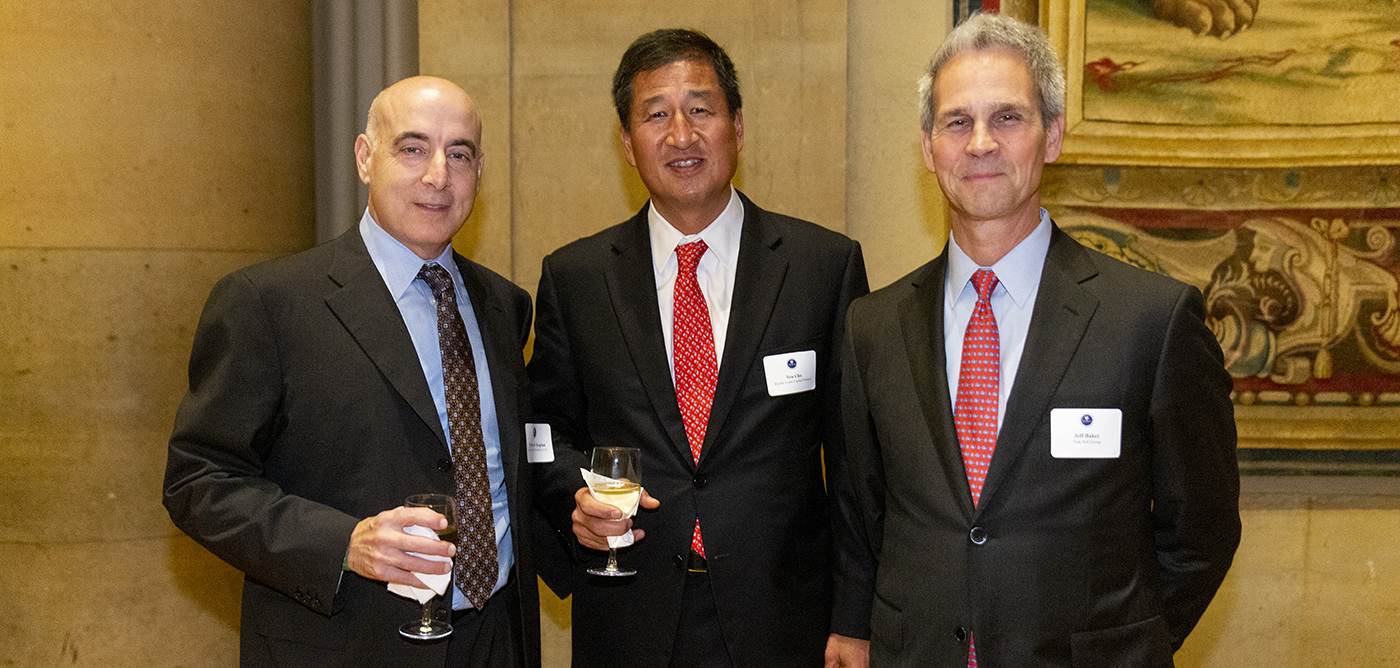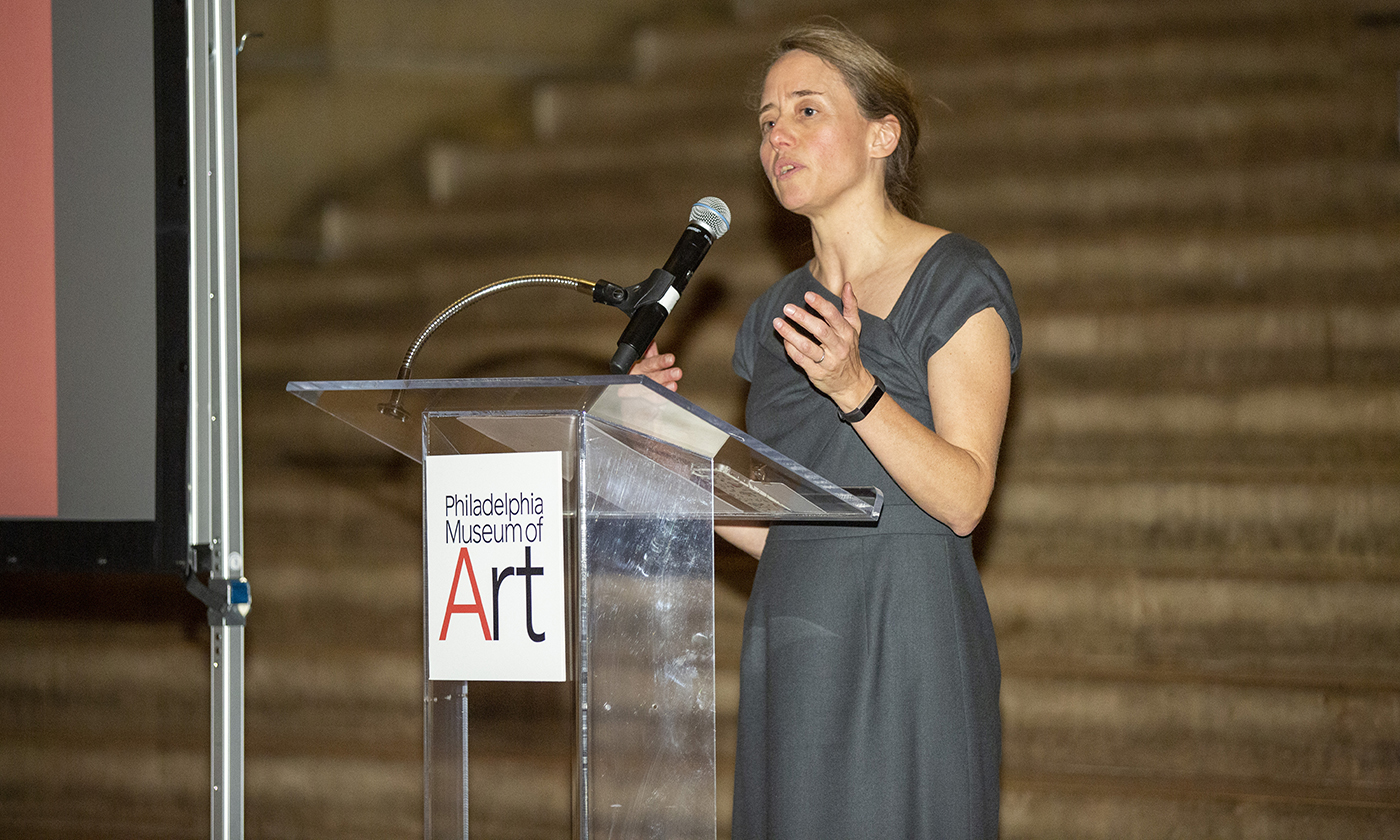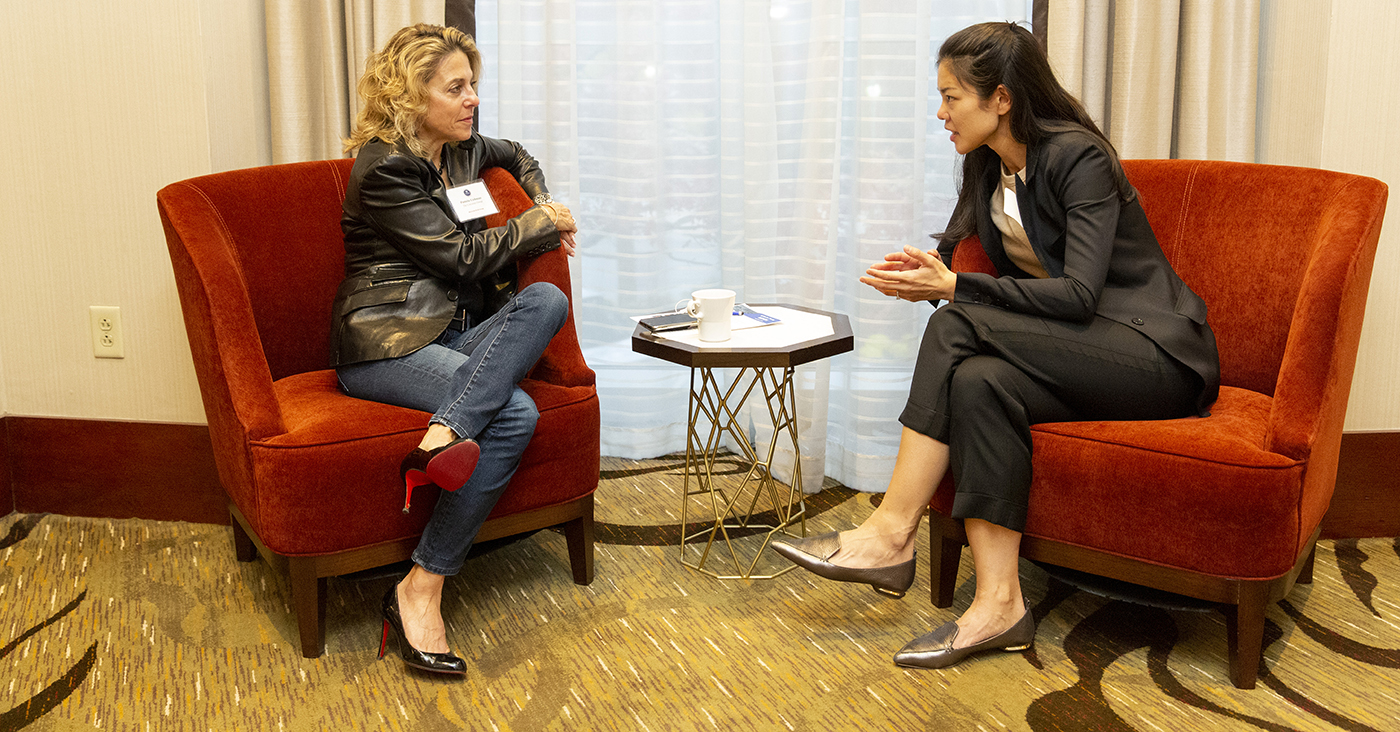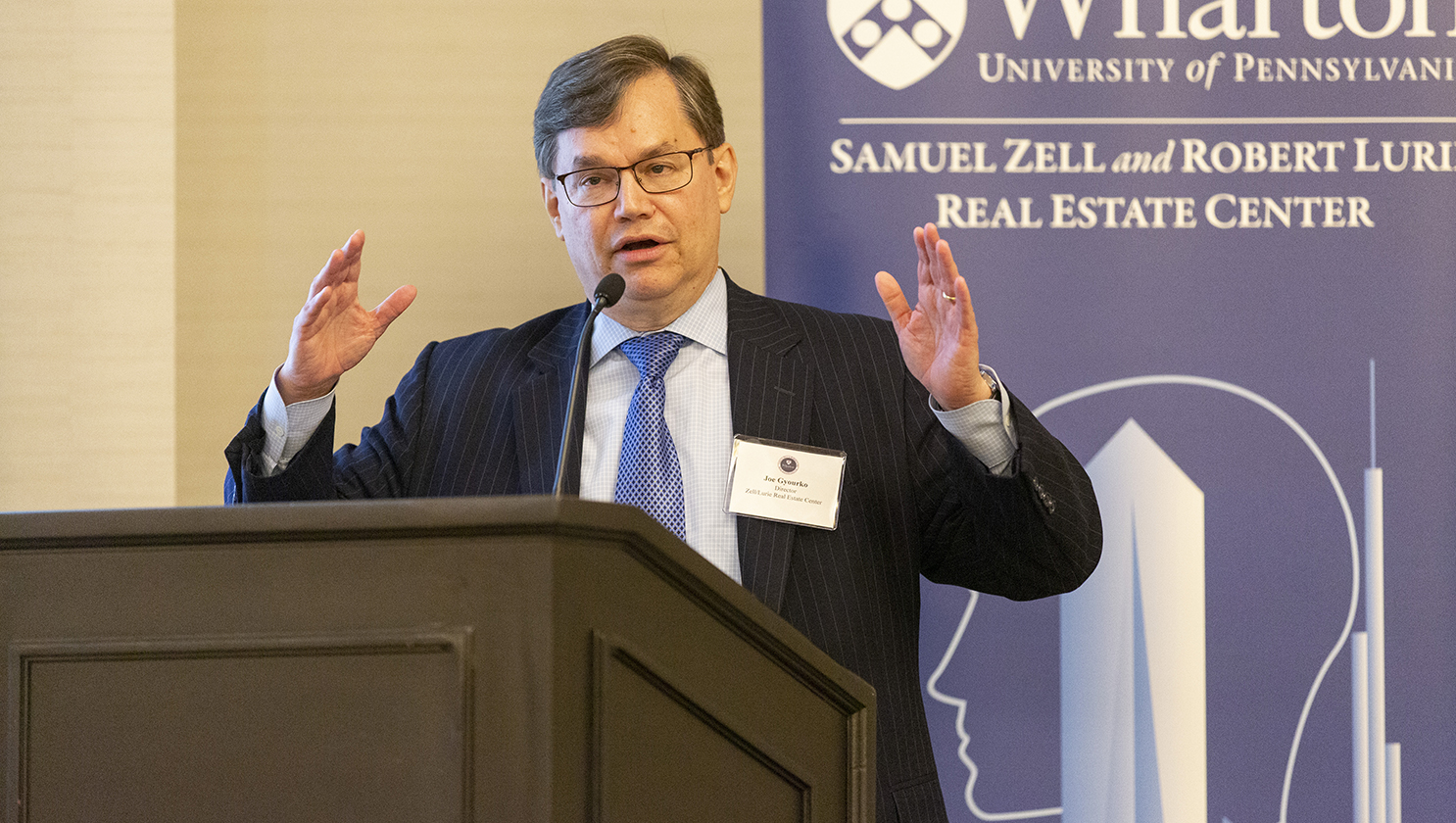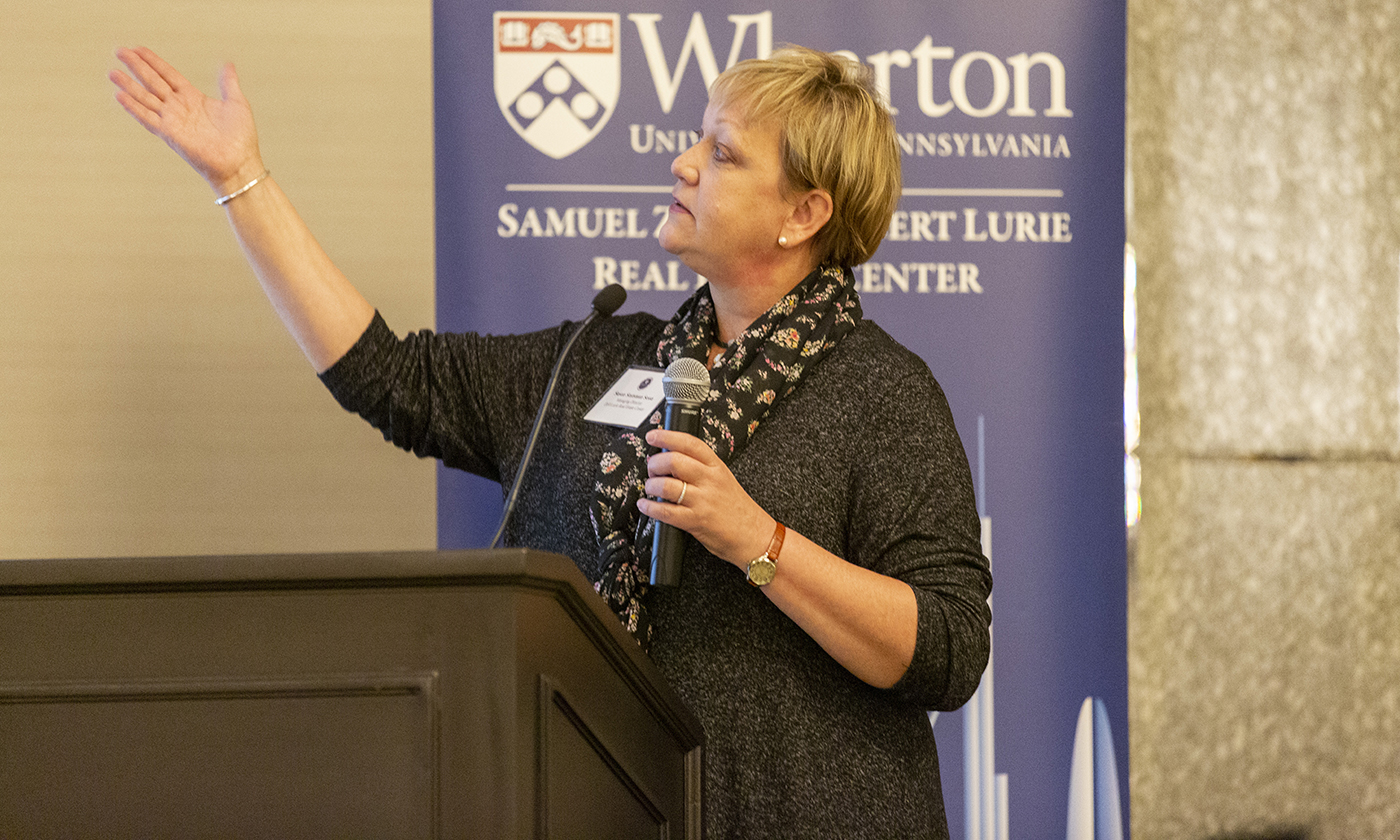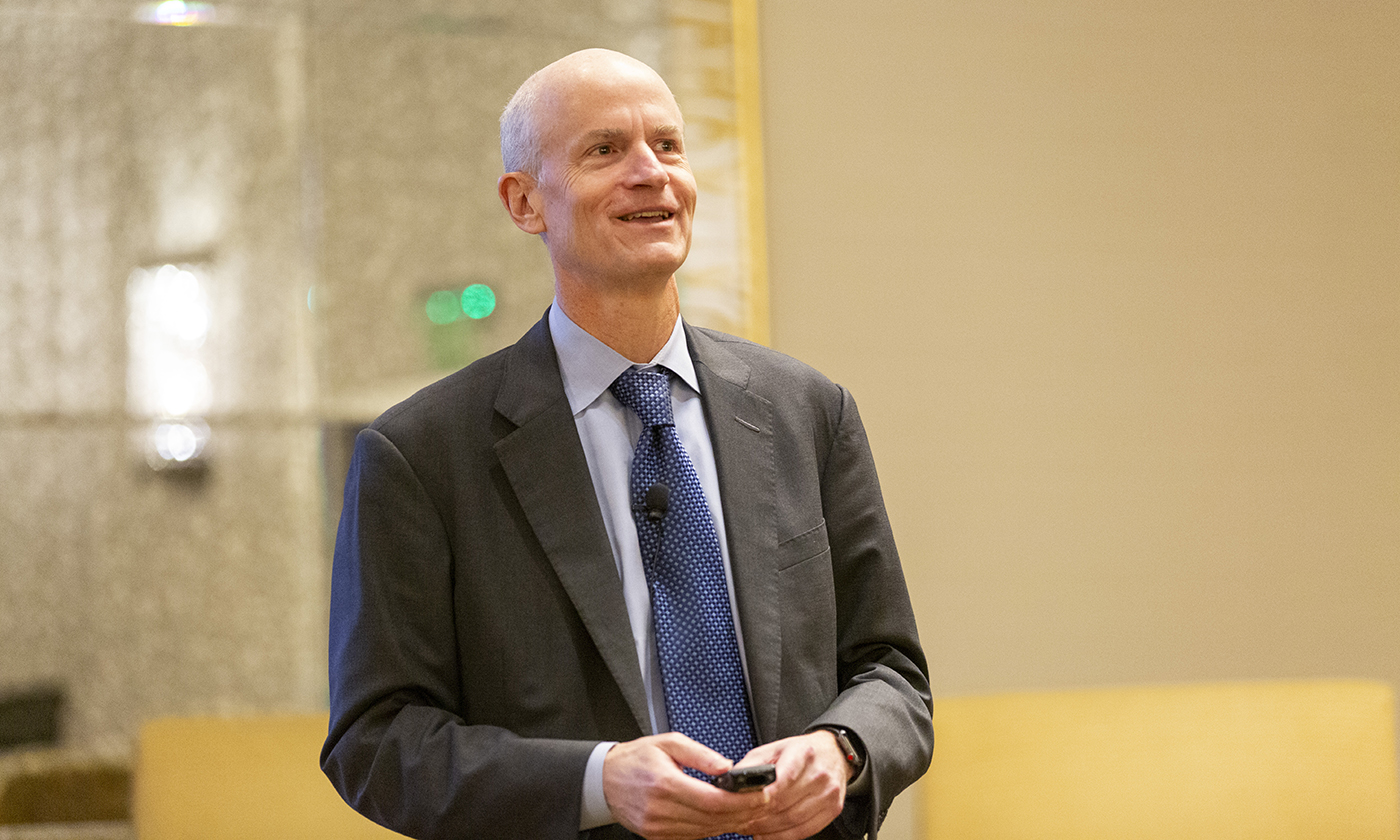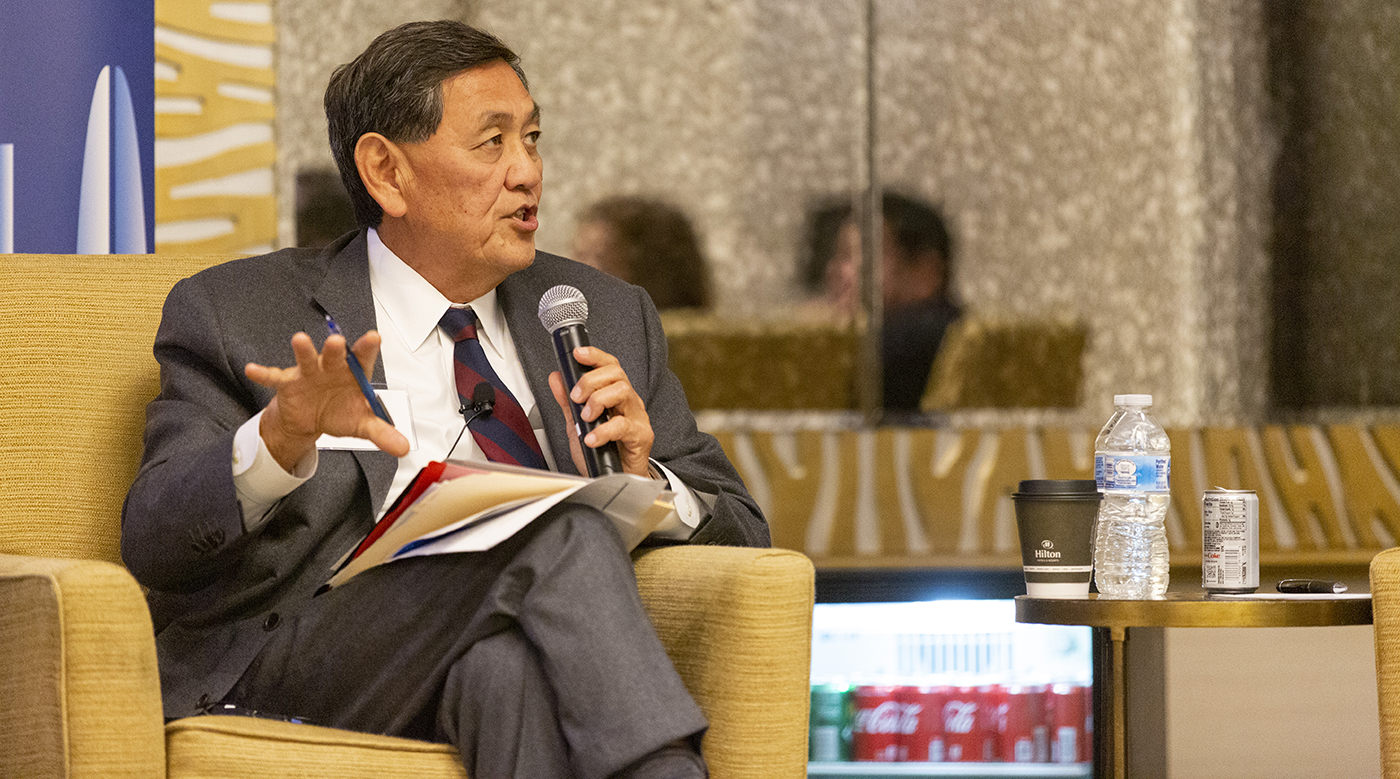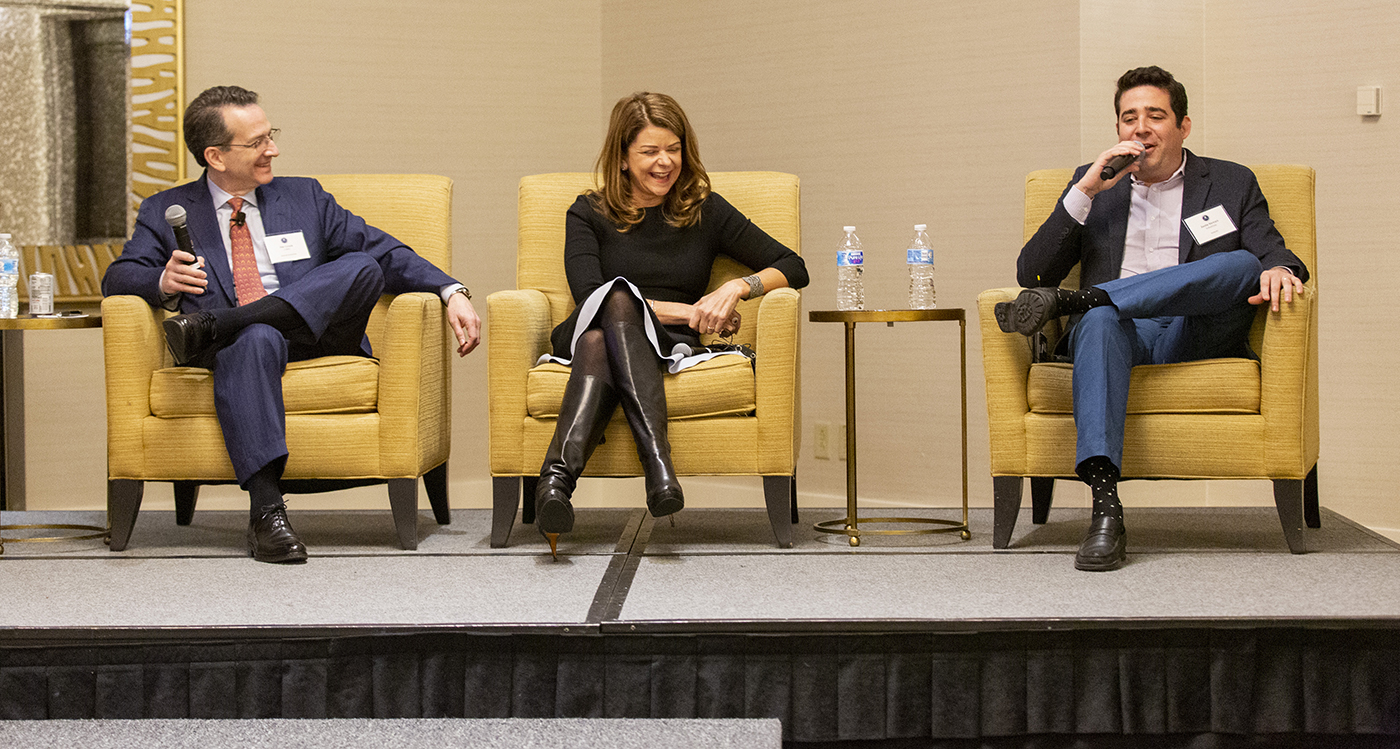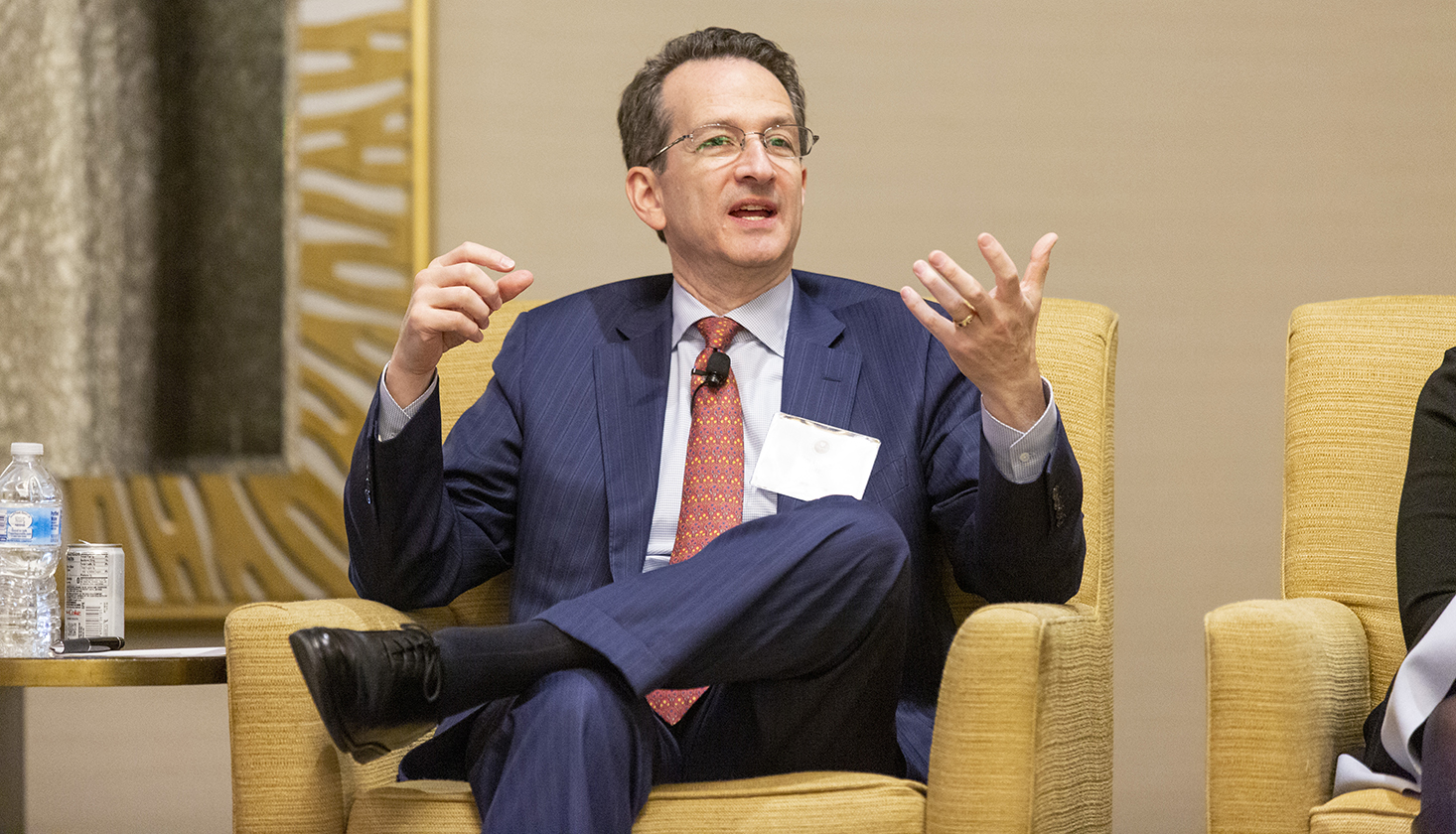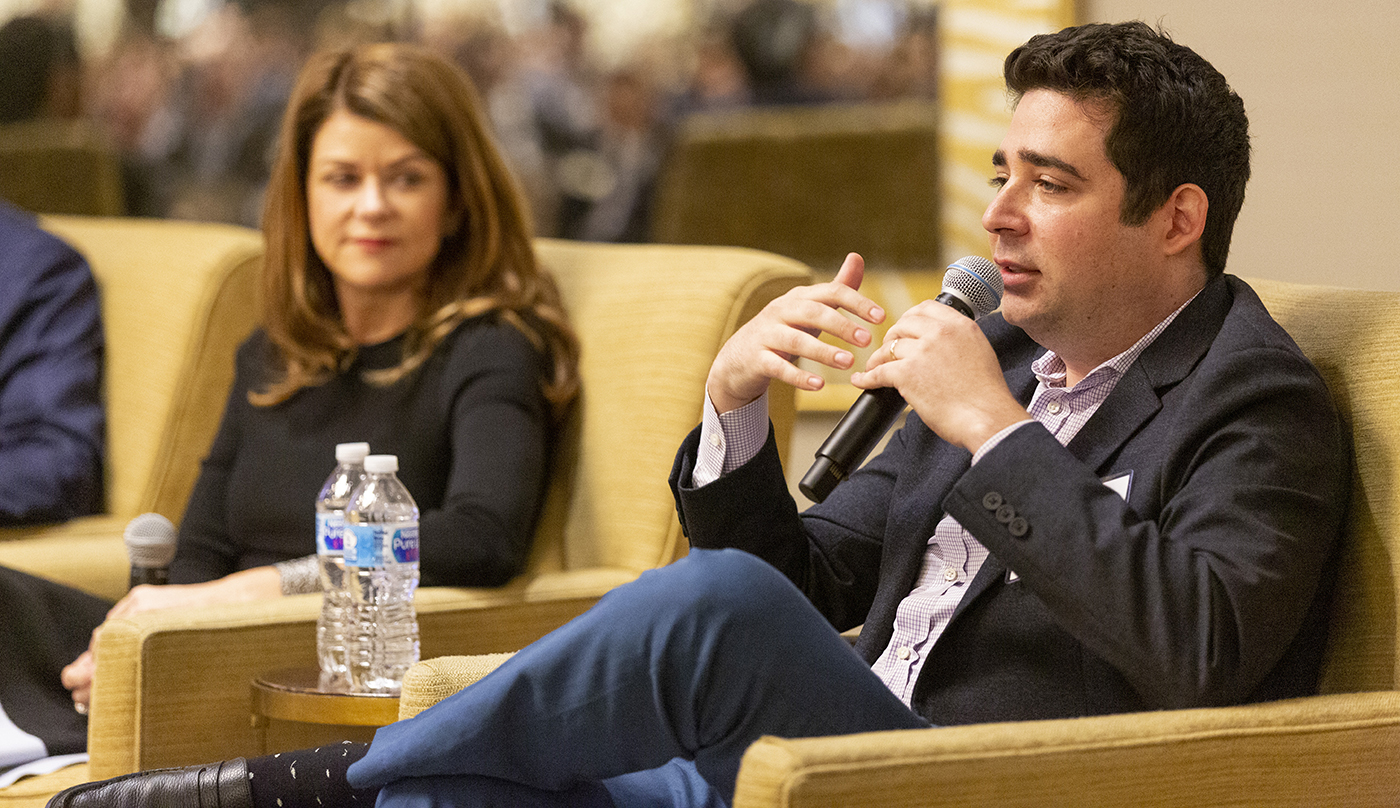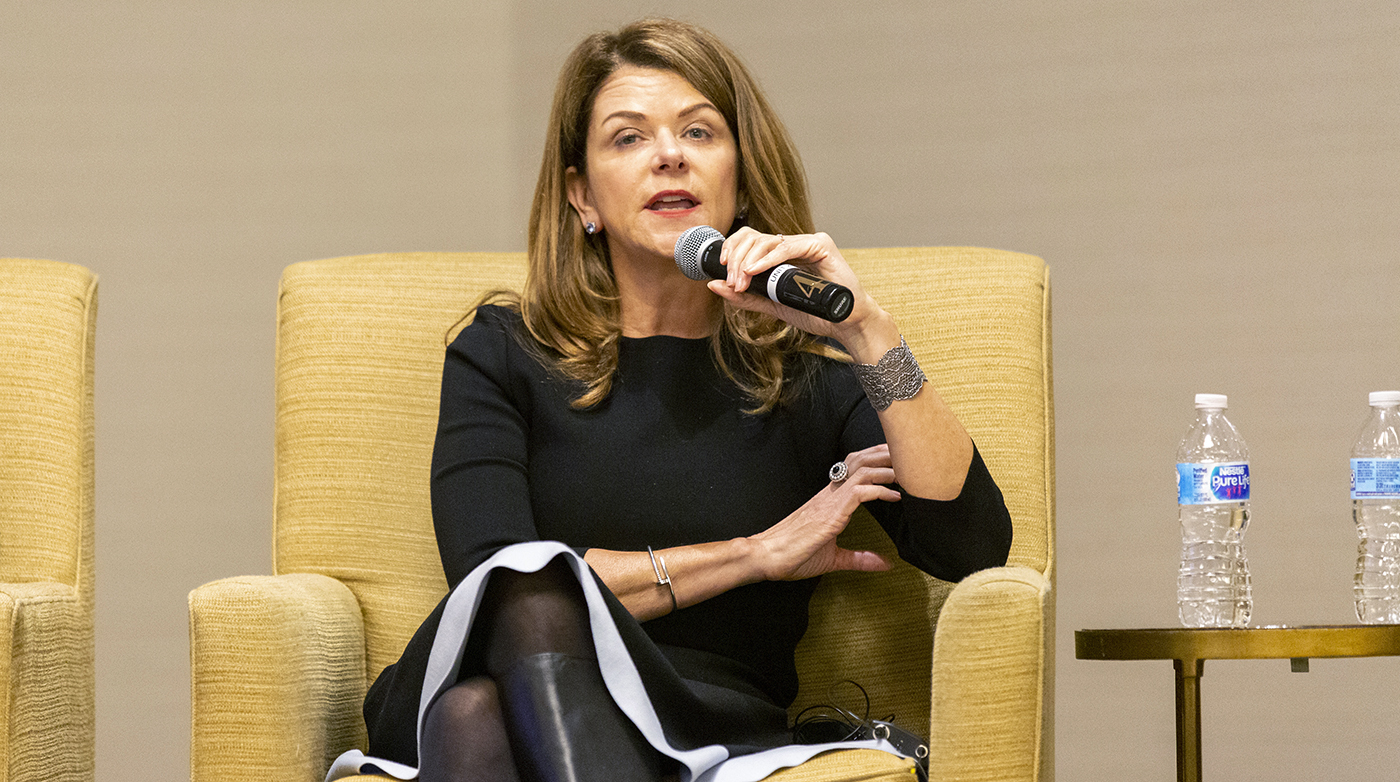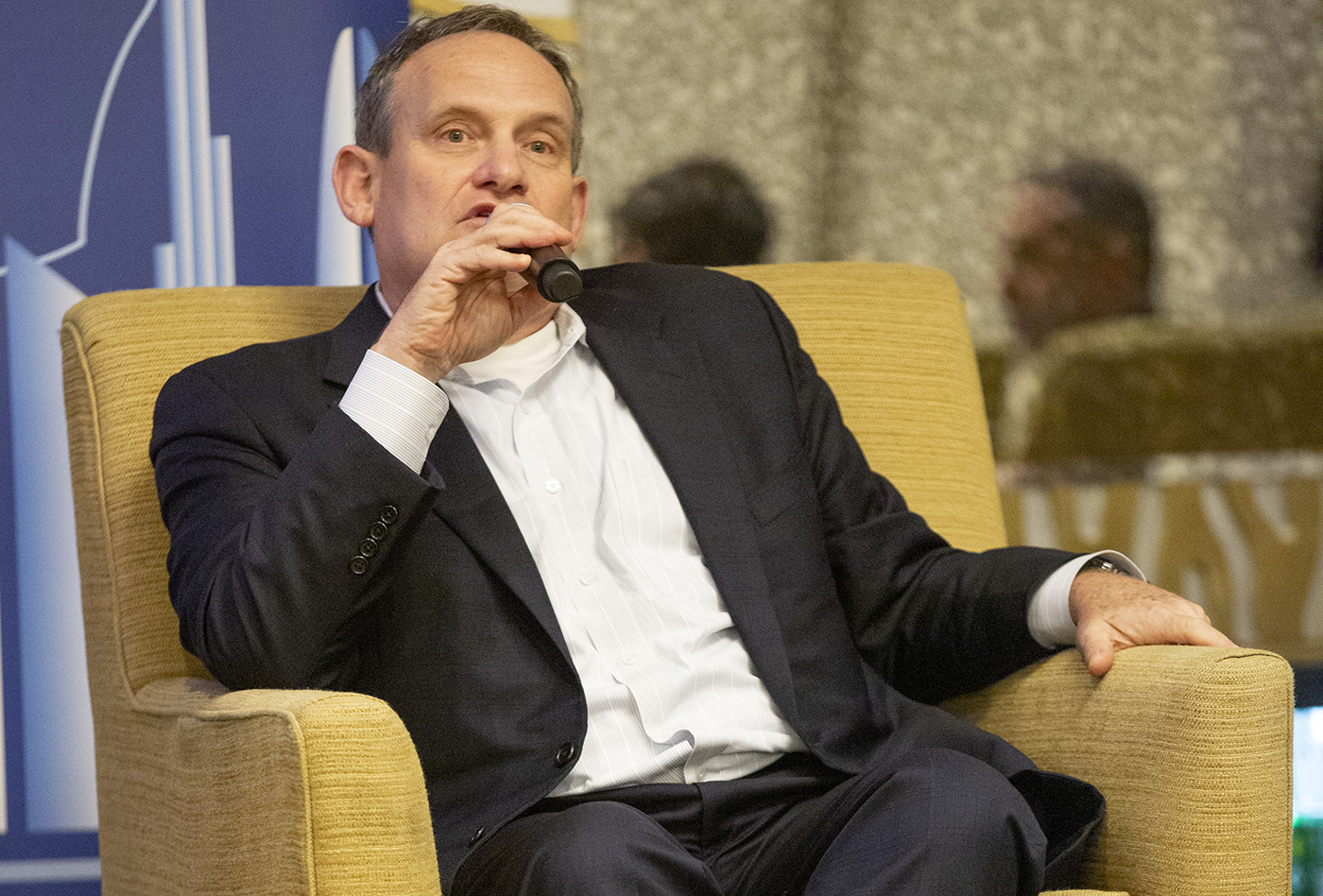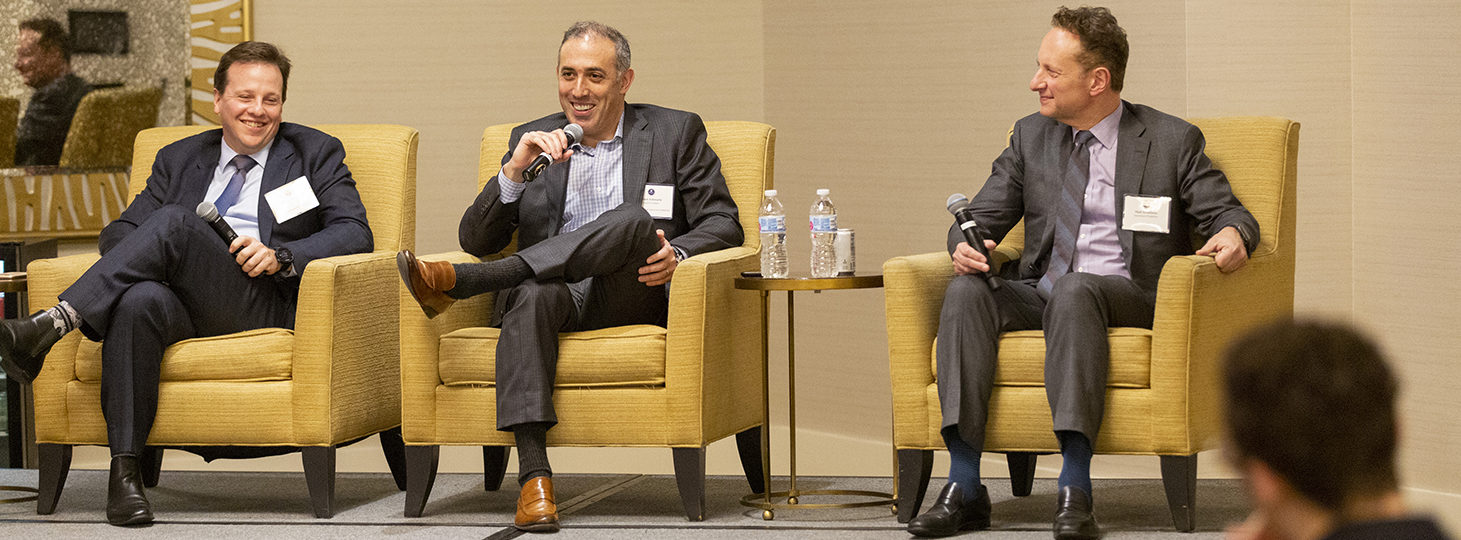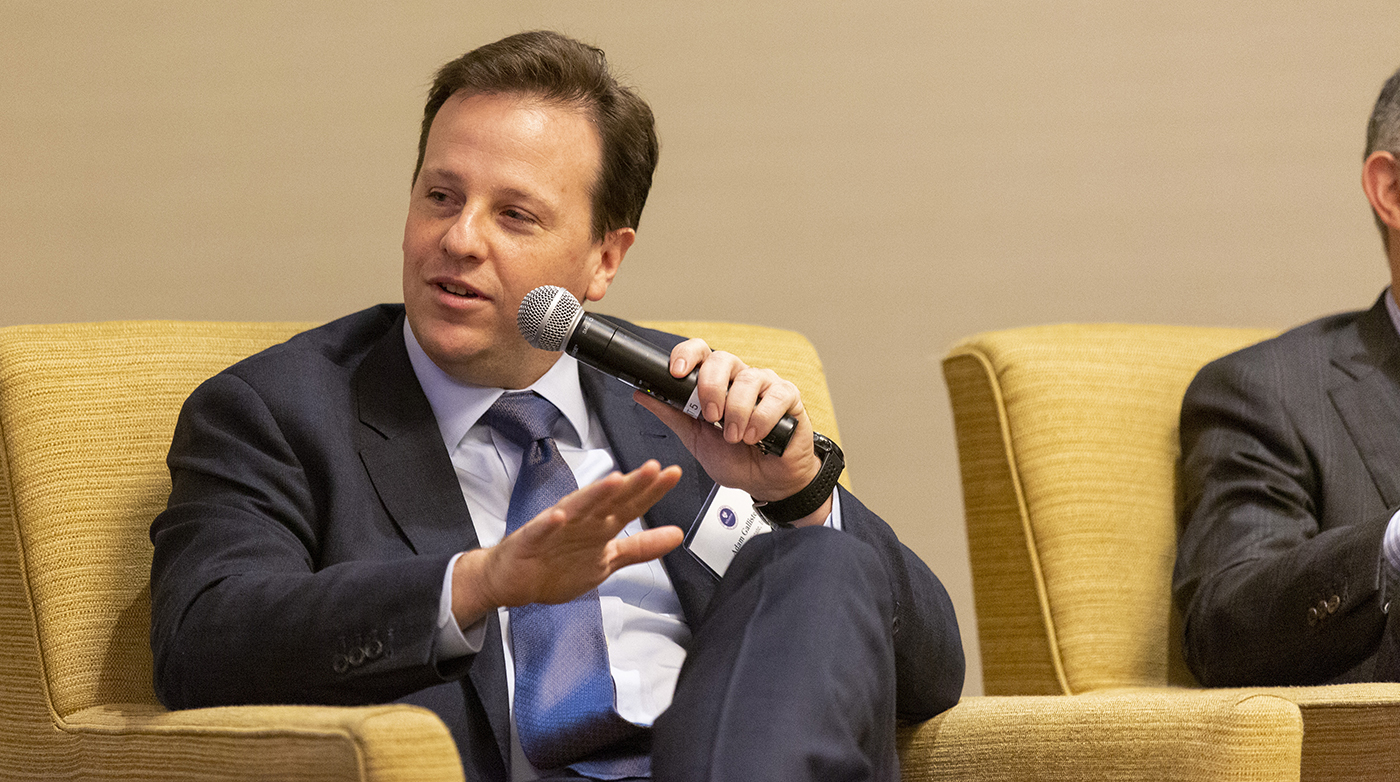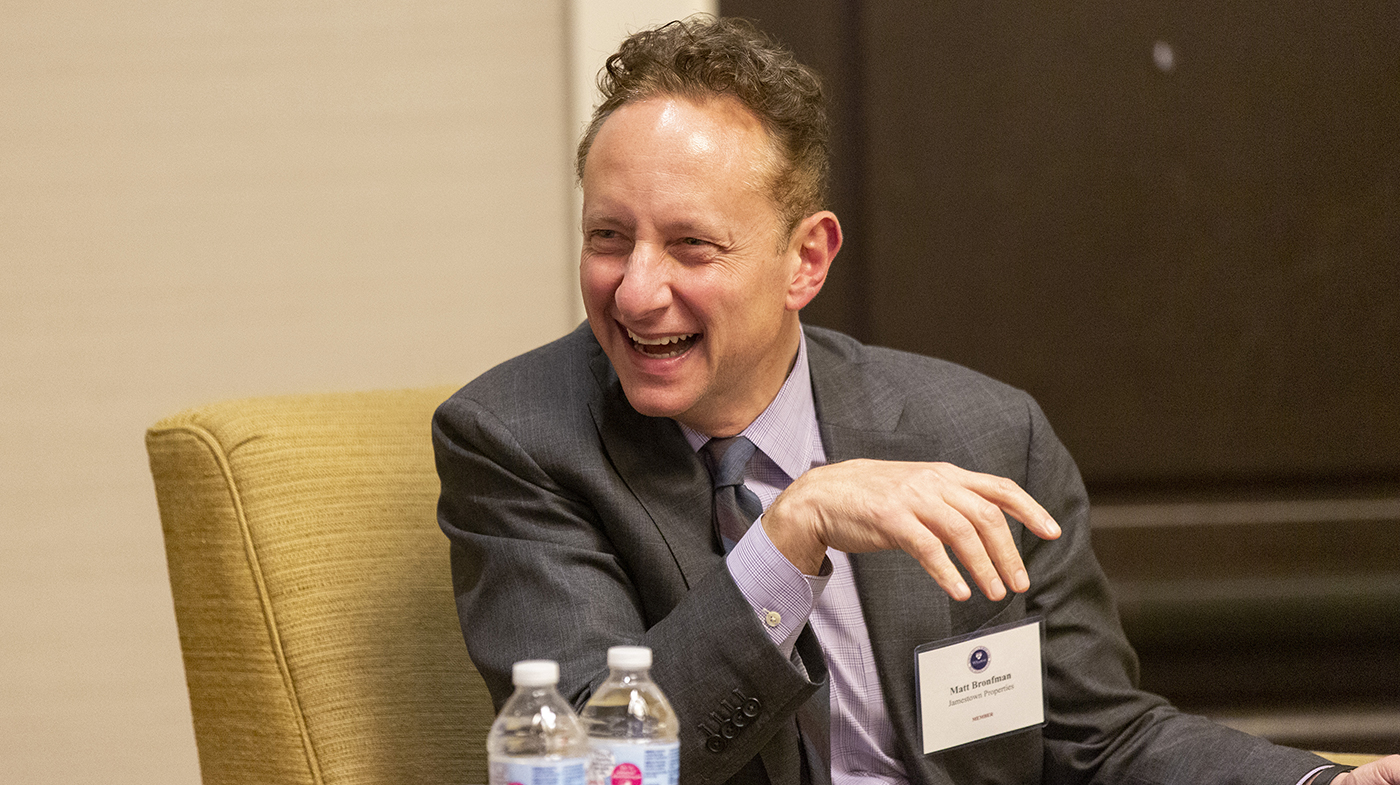2018 Fall Members’ Meeting Summary
Zell/Lurie Real Estate Center Fall 2018 Members’ Meeting
Thursday, November 1 – Friday, November 2, 2018
The Zell/Lurie 2018 Fall Members’ Meeting began with a dinner and talk for Zell/Lurie Research Sponsors, Executive Committee Members and guests at the Philadelphia Museum of Art. Jennifer Thompson, the Gloria and Jack Drosdick Curator of European Painting & Sculpture and Curator of the John G. Johnson Collection gave an engaging and informative talk entitled Philadelphians Collect: A Brief Introduction to the Museum and its Collections. Afterwards guests had the opportunity to tour the European Art 1850-1900 Galleries.
The following day’s meeting opened with a continental breakfast, during which mentors met with their student mentees and other guests had the opportunity to network.
The Zell/Lurie 2018 Fall Members’ Meeting opened with welcoming remarks from the incoming chair of the Advisory Board of Zell/Lurie Real Estate Center at the Wharton School, Matthew J. Lustig, who is Head of Investment Banking, North America; Head of Real Estate & Lodging, Lazard.
The bi-annual State of the Center message was given by Joe Gyourko, Nancy A. Nasher and David J. Haemisegger Director, Zell/Lurie Real Estate Center at the Wharton School, and Susan Sessa, Managing Director, Zell/Lurie Real Estate Center at the Wharton School. Gyourko explained the day’s agenda and the Center’s mission:
Providing thought leadership to the real estate community by supporting cutting-edge research for current and future business leaders and policy makers; facilitating a partnership between industry professionals and Wharton faculty and students; and providing for innovative inquiries and excellence in education; making research accessible and providing a forum for the real estate community to discuss critical issues.
Of the 200 Center members, 92 are Research Sponsors and the balance are Sustaining Member firms. Gyourko said he is always open to suggestions for new members. He then congratulated faculty members Maisy Wong, Todd Sinai and Fernando Ferreira, all of whom have been appointed to new professorships in the past year.
Upcoming meetings include the Spring Members’ Meeting on May 1 and 2, 2019, and the Grayken Program in International Real Estate in London on May 22, 2019.
Two long-time members were memorialized with a moment of silence. Marshall Bennet, 97, a Navy veteran who served in WWII, and was one of the earliest members of Wharton’s real estate program, and Jeff Barclay, a mentor for many students over the past two decades, passed away recently.
Sessa briefly discussed the research sponsor program and the small group events that are held off-campus throughout the year. She explained the benefits of becoming a research sponsor and reminded everyone of the alumni directory and student resume book found on the center’s website.
The morning began with featured speaker, Owen Thomas, Chief Executive Officer of Boston Properties (BXP), who discussed The State of the Office Market—Where We’ve Been, Where We Are, and to Where Shall We Go?
Thomas opened by describing Boston Properties as the largest public company in office space. As a ground-up developer with $4 billion in development today, he says their goal is to create value at the real estate level. The company uses its own money to purchase great sites and great buildings that they hold for the long-term. BXP focuses on premium buildings in the gateway markets of Boston, New York City, Washington, D.C., San Francisco and Los Angeles.
The company takes a different approach than many of their peers who operate regionally, and it is increasingly a CBD company and growing.
He talked about one of their most recent developments—the Salesforce Tower in San Francisco. At more than 1,000-feet-tall, it is the tallest building west of Chicago.
Thomas stated that in his opinion, the timing of the next recession will depend on how the political landscape develops. He asked the audience to weigh in by a show of hands, and the majority voted that the next downturn would come after 2020. He said he believes the country will “settle down” at 3 to 4 percent economic growth going forward.
Now that the stimulus is wearing off, at some point, the Fed will raise rates. Will real estate values decrease? And if so, as much as in 1990 or 2007? “My instincts say probably not,” he said. “There is lots of private equity on the sidelines and interest rates are low relative to the last time, providing a cushion.”
Thomas continued by discussing office net absorption. In their efforts to save money, companies are trying to fit more employees into smaller spaces and that densification is challenging the office business. Although data is scarce, based on the existing figures, there has not been much creation this cycle; lenders are more disciplined and it is impossible to get a loan to build an office building on spec, which has kept construction at modest levels.
BXP selects its market based on scale vs. rent growth. “When you have 300-million-square-feet and the average lease term is 7 years, you can calculate,” he said. “There is a real market in big cities to fill those spaces. It’s an important phenomenon. And we look for markets where rents for each cycle have been higher.”
Thomas also discussed the trends of urbanization and low unemployment in the office market; because of the latter trend, keeping talent is the most important issue for his business tenants, causing them to develop increasingly attractive workspaces, often with unprecedented amenities.
Other elements having an impact on the office space sector include transportation (including ride-sharing services like Uber and Lyft) and artificial intelligence. Thomas predicted that there will be major segments of white collar employment that will be disrupted by AI. Jobs will be created, but right now it is unknown just who will be disrupted and where. “We have to ensure we have the right real estate in each area,” he said.
He also discussed the impact of emerging locations as the definition of CBD evolves, amenitization, co-working space, and sustainability, which is both the “right thing to do” and what customers want.
At the end of his presentation, Thomas fielded several questions about co-working build-outs: This trend is not going away and has a positive impact on the buildings and neighborhoods in which WeWork and Industrious and others have established themselves. He disputed the assumption that all occupants of co-working spaces are tech workers. “Only 20 to 30 percent of workers in those spaces are tech workers,” he said. And he stressed that all office space is basically “raw space” with a certain layout and then the tenant adds the amenities based on their individual culture and philosophy.
The first panel of the day, The Future of Office: A Deeper Dive into the Crystal Ball, addressed such questions as, have technology and other societal changes conspired to begin the disruption of the office sector? If so, how will these changes affect location, product, finance and the ways companies and buildings compete for tenants?
The panel was moderated by Asuka Nakahara, Associate Director, Zell/Lurie Real Estate Center at the Wharton School. Panelists were James Groch, CFO and Global Director of Corporate Development, CBRE; MaryAnne Gilmartin, Co-founder and CEO, L&L MAG; and Justin Stewart, President and Co-founder, Industrious.
The group picked up where Owen Thomas left off in his presentation and expanded on some of his comments, thoughts and theories.
Nakahara asked the panelists to react to Thomas’ presentation. Stewart began by agreeing that the co-working trend is here to stay, and explained that Industrious is “strategic and thoughtful” about its planning, listening to customers whose needs drive Industrious’ choice of location and style.
Gilmartin said that it is a good time to be a developer and agrees with the need to build sustainably. “Also, the idea [today] that companies are driven by the talent [and so want to build where they can find and keep good employees] is a game changer,” she said, adding that viewing this as a disruptor is not necessarily a negative. “We need great disruption in our cities in this country so we can build better, smarter buildings.”
Groch agreed that companies are changing the way they work within their own spaces, saying that CBRE has done that. “We created a dozen different work environments, from food, high ceilings and concierge services … We didn’t save money, but we got more efficiency and utilization of the seats,” he said. “The move is toward thinking of the individual and creating a better work experience. It’s how companies are thinking today and will create a greater value differentiation.”
Nakahara wondered if office landlords should worry about the co-working trend and shun short-term leases, memberships, etc. “Will landlords outsource that to co-working spaces or do more flexible terms?”
Stewart repeated that most realize that this is an evolving trend that is not going away. “As cap structures evolve and align with the tenants’ need for flexibility, they [the landlords] will have to be willing to pay more. It will be a slow process,” he said.
Gilmartin agreed that today’s struggle around the change in leasing structures is a struggle only because of the current business model. “As an industry, we only really change when we have to,” she said. “By definition, these new, flexible spaces lend themselves to more flexibility in leasing. The WeWork model has woken a sleeping giant. We all want to be in community; it’s how many want to work.”
The discussion continued around the benefits and downsides of the co-working structure, with comparisons made to the Airbnb model versus traditional rentals in an apartment complex. Stewart felt that one solution to the tensions between the new and old might be partnership agreements with the landlords.
“This is where we see the office market going,” he said. “If we team up through management agreements with the landlords, we can provide service and flexibility.”
Gilmartin, who has used Industrious spaces for her own team, supported Stewart, saying that the benefits outweigh any negatives in her opinion. “We plug in and go. There is no risk and no costs left on the table. The super flexibility works for us.”
Groch continued the conversation by agreeing with both of his co-panelists. “These aligned structures make a ton of sense as the world changes,” he said.
The group also discussed Thomas’ comments on autonomous vehicles and technology, with Groch wondering whether the use of the former could mean that businesses might move back to the suburbs since people might be able to work on their commute.
“What business trends are being underestimated?” asked Nakahara.
Stewart mentioned that what tenants really want is for the whole building to be amenitized. “They want to have classes, a gym, etc., for everyone, not just one or two floors,” he said. “We can manage the building on the landlord’s behalf from a service standpoint, so members feel happy and proud to come to work every day.”
Gilmartin echoed his statements, adding that the trend toward “smart” buildings and renovating older structures rather than building new—while also amenitizing from bottom to top—are not being given enough attention.
The discussion continued on its service-oriented and disruption themes: “The quality of the asset is still important, but the experience and service is also important, and technology enables them. It’s a mix,” said Groch. Real structural change is possible, but not easy and co-working has shaken up the business sector.
“In an industry that is rarely disrupted, co-working has shaken the whole thing up and made us think. I don’t know where it’s going, but it’s been remarkable to watch,” added Gilmartin.
After the lunch break, participants split up to attend one of five cohort breakout sessions held in Jon M. Huntsman Hall.
Cohort A; led by Mitch Clarfield, Senior Managing Director, Berkeley Point Capital; and Andy Isikoff, Managing Director, Silverfern; featured a talk by John Paul MacDuffie, Professor of Management, the Wharton School, the University of Pennsylvania; Director, Program on Vehicle and Mobility Innovation, Mack Institute of Innovation Management, the University of Pennsylvania; on Fast-Moving Vehicle & Mobility Ecosystems: How Much Disruption and How Soon?
MacDuffie explained three structural features of the auto industry: original equipment manufacturers, or OEMs, are the best positioned in the industry but are relying more and more on third party suppliers; the acquisition of startups; and intra-industry partnerships. He described the disruptive change of autonomous vehicles as a “once-in-a-century transformation,” quoting Toyota CEO Akio Toyoda.
MacDuffie went on to focus on the ideas of electrification, connectivity, autonomy and shared mobility. He noted that electrification of vehicles does not inherently threaten OEM’s roles or value propositions and could be easily incorporated into car manufacturers’ existing supply chains.
During the session’s Q&A section, MacDuffie was asked where it was likely that autonomous vehicles will be stored. He answered in two parts: (1) fully autonomous vehicles owned by providers likes Uber may never need to park, stopping only to recharge, and (2) autonomous vehicles owned privately may either circle around continuously until they are needed or park on the outskirts of the city when not in use.
Cohort B; led by Robert Bellinger, CFA, President, CEO & Executive Portfolio Manager, ASB Real Estate Investments; featured a talk by Lorin Hitt, Zhang Jindong Professor of Operations, Information and Decisions at the Wharton School, the University of Pennsylvania; on The Business Value of Data Analytics.
Hitt explained how new data tools and deep-learning technology can be utilized in order to develop more data-driven insight in the real estate sector. He discussed the importance of hiring and dispersing employees with data analytic skills across departments (not solely marketing) because data literacy is associated with higher performance – 87% return on sales.
Hitt continued to describe to discuss “big data” and social media. He detailed how companies can analyze their social media engagement: measure presence and effectiveness by examining how many users like and share their posts.
During the session’s Q&A section, Hitt was asked how data analytics and social media apply to commercial real estate. He answered in two parts: (1) companies are able to discover new information such as user personal preferences, and (2) companies can use social media to promote and connect with potential tenant.
Cohort C; led by Denise Olsen, Senior Managing Director, GEM Realty Capital, Inc.; and Carl Tash, Chief Strategist, Starwood Retail Partners; featured a talk by Olivia S. Mitchell, International Foundation of Employee Benefit Plans Professor; Professor of Business Economics and Public Policy; Professor of Insurance and Risk Management; Executive Director, Pension Research Council; the Wharton School, the University of Pennsylvania; on Facing the Challenge of Public Pensions.
Mitchell explained the structure of pensions, giving a historical perspective on a time when they were held on 100% government bonds, which was widely criticized.
She then outlined the two types of pension plans presently available: defined contribution (DC) plans and defined benefit (DB) plans. She explained that people need to be nudged to save with DC plans. Some programs are mandatory (Chile), and some are voluntary (USA 401 (K).
In the case of DB plans, the benefit formula is specified, i.e. 2% x final pay x years service. These are mostly used in US public sector pensions and social securities.
Mitchell cautioned the audience, saying “Actuaries today expect that the first baby to reach 200 years old has already been born. The Social Security Trust Fund will be gone in 2034, so my advice to you as it’s going to get expensive to get old; don’t get old, just keep working.”
During the Q&A portion of the session, an audience member asked what states that are “in the black” on pensions have done right compared to those that are “in the red.” Mitchell answered that most have converted to the 401k/DC plans.
Cohort D; led by David Helfand, President and Chief Executive Officer, Equity Commonwealth; and Andy Jonas, Managing Director, Goldman, Sachs & Co., LLC; featured a talk by Brian McKeon, Senior Director of the Penn Biden Center for Diplomacy & Global Engagement; on U.S. Foreign Policy and the Changing World Order.
McKeon opened by explaining the “new world order” established at the end of World War II by the leaders who “picked up the pieces.
“They established institutions designed to prevent the chaos in the future: the United Nations, International Monetary Fund, World Bank, World Trade Organization, North Atlantic Trade Organization and others, and encouraged the countries that eventually became the European Union,” he said. “They also promoted human rights and democracy by building a web of alliances that promoted peace and economic development around the world. It wasn’t perfect or linear, but they avoided World War III, stopped wars in Europe and helped lead significant advances in human rights and prosperity.”
McKeon said that during the last four administrations, the global approach was more or less always based on the advancement of democracy and human rights, global defense and free markets, however, the current administration seems less concerned about past alliances, which is a departure from Republican orthodoxy.
Changes around the world have caused many countries to become more nationalistic and less global in nature, including the massive European migration; technology, which has shifted how people work and allowed for the theft of elections and intellectual property; the shift in jobs and rising inequality and resentment; loss of faith in government; and terrorism.
He spoke of the reaction of world leaders to Donald Trump’s leadership style, especially if he gets a second term. “These countries will hedge their bets,” he predicted. “For example, the Transpacific Partnership, the Iran deal and the Paris Climate agreement are all going on without us. Germany has said publically that they can’t rely on us anymore.”
During the Q&A segment, McKeon answered the big question: “Will Joe Biden run for president in 2020?”
“There is a 50/50 chance,” said McKeon. “He said he will make a decision and let people know in January.”
Cohort E; led by Cia Buckley Marakovits, CIO, Dune Real Estate Partners; featured a talk by Michael Knoll, Theodore K. Warner Professor of Law; Professor of Real Estate, the Wharton School, the University of Pennsylvania; on Corporations and Tax Policy.
Knoll provided an overview of potential tax reforms that would be relevant to real estate. He explained that although most real estate businesses are partnerships, there are potential tax advantages attached to becoming a corporation.
Knoll then discussed a basic tax consideration: converting to C Corporation. He said that most real estate companies are structured as “pass-through” entities (corp. or LLC.). He continued to discuss a new tax bill that has changed the relative benefit of pass-throughs. Knoll stated that he believes that widespread conversions to C Corporations are unlikely to occur despite the two major benefits of conversion: growth opportunities and opportunity for reinvestment.
During the Q&A session, an audience member asked, “What if you are the long-term owner of a single asset and you run out of depreciation?”
Knoll responded, “If you have held the property beyond its depreciable life, the section 199A deduction is no longer applicable.”
The final session of the day and second panel, What Are Your Thoughts … ? Investing, Risk Adjusting and Fundraising Strategies in a Long Cycle with Massive Disruption in the Air, opened with moderator, Ron Kravit, Co-head of North American Real Estate, Managing Member, Cerberus Real Estate Capital Management, LLC; Senior Managing Director, Cerberus Capital Management, L.P.; and Vice Chair, Advisory Board, Zell/Lurie Real Estate Center at the Wharton School, asking the panelists a series of questions designed to learn more about them and their style.
Panelists Adam Gallistel, Regional Head, Americas Real Estate/ Managing Director, GIC Real Estate, Inc.; Adam R. Schwartz, Co-Chief Investment Officer, Head of Real Estate, Angelo Gordon; and Matt Bronfman, Chief Executive Officer, Jamestown, L.P., then discussed the ongoing business cycle and their thoughts about how to risk adjust in today’s market, given the state of the world.
“We’re past the time in the cycle where you can make money and look like a hero,” Schwartz answered. “You need to perform on what you buy right now. We buy things that are broken and fix them up and we like cash flow, which does a lot to protect your downside.”
Bronfman expressed similar thoughts, adding, “You have to assume construction costs will go up. We think five-to-ten years out and have to really believe we can drive net operating income over the next few years. We assume we’ll be selling at higher cap rates than today.”
Kravit said, “But you can’t control that cash flow once a downturn hits.” Bronfman replied, “You can drive tenants to your property, and we buy real estate we think we can make great. There may be a struggle, but we think we can outperform the market by having something special.”
Adam Gallistel said that he takes a different angle, by focusing on non-traditional real estate. “Generally speaking, they tend to trade at higher yields among other things, and finance as well as traditional real estate. They’re not recession proof, but dips are likely to be less.”
The panel took some time to discuss the differences between the GP and LP approach and alignment of interests as well as where to find the best risk return reward.
Kravit then asked, “What is the degree of difficulty in getting deals done today?”
“It’s hard. We’re not finding a ton of deals, and that hasn’t changed much in the last two years,” answered Schwartz. “Prices stay flat or go up a little bit, and it’s really easy to kill a deal. Our pace is off from last year, which was off from the year before. Europe is easier and Asia also is active.”
Bronfman agreed. “Over the last six months to a year, we’ve hoped things would get better with higher interest rates, as cap rates go up. But there is no change in asset pricing. We thought we’d see more.”
Gallistel also agreed. “Around the world, when we look at likely outcomes, the odds of outperforming has not kept up.”
The men then agreed that the market looks healthy, but they are waiting for something to happen. They said it is mentally harder to find the right mindset to do a deal.
“What concerns do you have?” Kravit asked. “I believe we’re near the end of the cycle. Things in the world are different.”
The panel talked about affordability and the broader political risk that no one has yet figured out how to address. As in earlier discussions, they said that technological changes are both positive and negative: connecting everyone around the world, yet bringing with it a transparency that allows those users to feel left out—what happens in other parts of the world affect us all.
The Spring Members’ Meeting will be held May 1-2, 2019.
Posted December 2018


